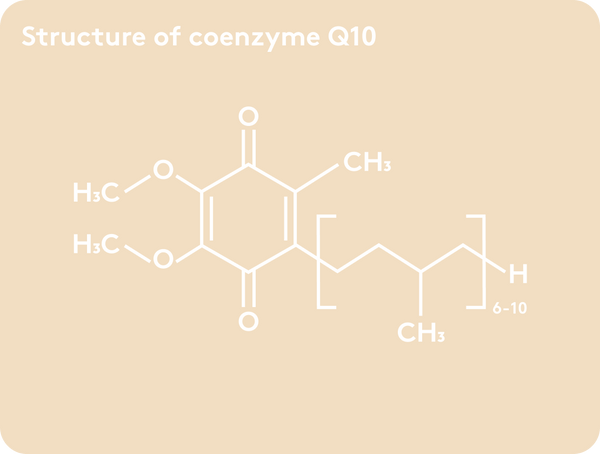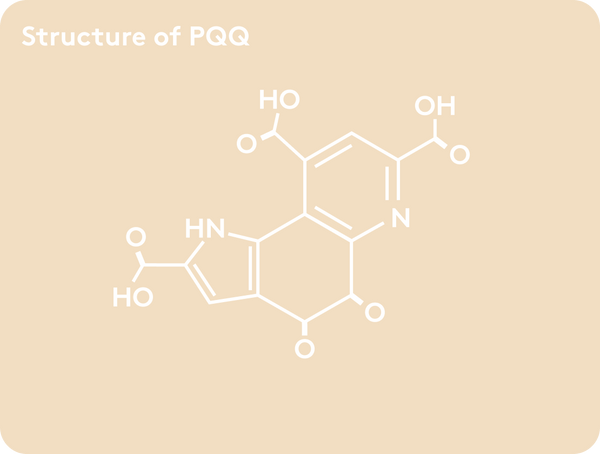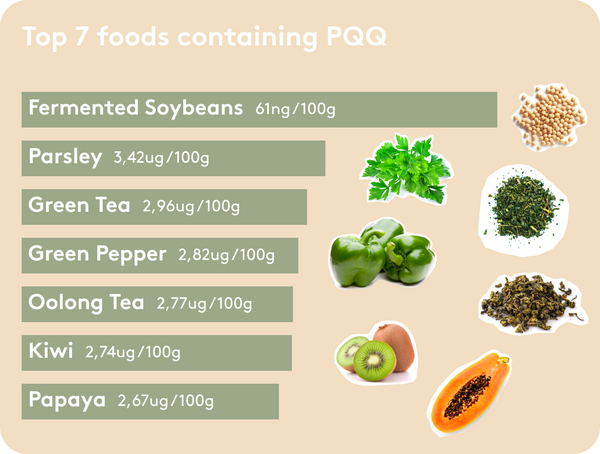Themen dieses Blogartikels:
Knowledge for your ears!
No time to read? You can listen to Claire's article here.
What is Coenzyme Q10?
Coenzyme Q10 is structurally related to vitamin K, but is not a vitamin itself. Nevertheless, the term vitamin Q10 is extremely common in many circles. Only those substances that cannot be produced by the body itself are referred to as vitamins. Coenzyme Q10, on the other hand, is a substance produced by the body and is also called ubiquinone-10 or ubiquinol. The term coenzyme means that for a reaction in the metabolism this substance is used and consumed. Without the coenzyme, the reaction cannot take place.
For the biochemistry fans among you: It is a quinone derivative with an isoprene side chain with a length of 10 units. It is produced in the body using the same metabolism that produces cholesterol.
Back to the actual topic: What does coenzyme Q10 do in the body?

What are the benefits of coenzyme Q10
In your cells, Q10 is mainly found in the mitochondria, more precisely on the inner mitochondrial membrane. Like many other coenzymes, ubiquinol is involved in the respiratory chain by acting as an electron carrier. The respiratory chain is the process within the mitochondria in which the greatest amount of energy can be produced. Energy production works by transporting more and more electrons from molecule to molecule and, through various processes, eventually enough energy is available to be converted into the universal energy carrier ATP.
Without coenzyme Q10, almost nothing works in the mitochondria and the energy production that takes place there. Q10 is connected to the beginning of the electron transfer chain. If the beginning does not work, it can not continue and much less energy is produced. Coenzyme supports your mitochondria in the body to produce more energy.
You can imagine it: Such a coenzyme Q10 deficiency you will feel.

When might you have a Q10 deficiency and how can you manage it?
There are several reasons why you may not have enough coenzyme Q10. These include:
- A blockage of the production pathway due to medication; treatment with statins, or cholesterol-lowering drugs, can result in Q10 deficiency because the body's own synthetic pathway (a branch of cholesterol synthesis) is inhibited1.
- You consume a lot of coenzyme Q10 and regenerate too little; normally coenzyme Q10 is not really consumed, but regenerated again; if this does not happen (for example due to radical stress2, or a slow enzyme3) you have too much coenzyme Q10 consumption and the synthesis is difficult to keep up with.
- You have an increased need that you have not met before; this includes, for example, athletes as well as pupils and students
- You have been taking antibiotics for a long time; they damage your mitochondria in the long run4 and thus energy metabolism. The need for coenzyme Q10 is therefore increased.
- As you can see, there are several reasons for an existing coenzyme Q10 deficiency. Symptoms include fatigue, muscle weakness and rapid muscle overexertion as well as concentration problems. It may then be worthwhile to supplement coenzyme Q10 as a dietary supplement. As Q10 capsules, or in liquid products, the important coenzyme runs through our entire product range.
Where is coenzyme Q10 found?
Coenzyme Q10 is found in some foods, so it can be supplied through the diet. Since Q10 is found in animals and also humans especially in organs that have a high energy demand and consumption, especially fatty fish, meat and offal (heart and liver) are rich in coenzyme Q10. Nuts and seeds also contain coenzyme Q10.
What is PQQ?
PQQ stands for pyrroloquinoline quinone and is also a coenzyme in your body. It was not until the turn of the century that this substance was recognized as a cofactor in metabolism. Like coenzyme Q10, it takes part in important reactions, especially in the mitochondria. Because you cannot produce PQQ yourself, it is possibly a new vitamin. This would make it the first new vitamin in over 70 years!
Fair enough. So what do we know about PQQ? What justifies its possible designation as a vitamin?

What is PQQ capable of?
There are already more than 1,100 entries about PQQ on Pubmed, one of the largest research platforms for medicine. Popular search entries include "PQQ and mitochondria" and "PQQ and inflammation". We have compiled a small list of the known functions of PQQ in the body together with the studies for you to read:
- PQQ can strengthen mitochondria, thus cause mitochondria to grow and produce more energy5
- PQQ may promote the production of anti-inflammatory messengers and thus contribute to inflammation regulation5
- With PQQ, the respiratory chain is increasingly activated
- PQQ may reduce oxidative stress, potentially supporting healthy aging6
- PQQ can renew coenzyme Q10 so that it can continue to function in energy production7
Which foods contain PQQ?
Which foods contain PQQ?
Infants receive their daily dose of PQQ from their mother's milk. After that, food must be sufficient. Foods that contain relatively high levels of the novel substance PQQ include fermented soybeans, green tea, spinach, beans, cabbage, kiwi, and papaya8. As you can see, PQQ is mainly found in plants, but less so in animal products.

The perfect pair: PQQ and coenzyme Q10
If two things belong together, it's PQQ and coenzyme Q10. Why?
Coenzyme Q10 is especially important in the respiratory chain for energy production. If your body has to deal with increased radical stress, coenzyme Q10 can no longer be regenerated so well. PQQ supports this process by directly regenerating coenzyme Q10. Taking PQQ and coenzyme Q10 together is therefore much more effective than just taking coenzyme Q10.
PQQ is an important antioxidant and can reduce oxidative stress. Thus, PQQ contributes to mitochondrial health. With coenzyme Q10, energy production is promoted. So together, the Power Couple can do quite a lot!
This article is based on carefully researched sources:
Sources & Bibliography
- Potgieter, M., Pretorius, E., & Pepper, M. S. (2013). Primary and secondary coenzyme Q10 deficiency: the role of therapeutic supplementation. Nutrition reviews, 71(3), 180–188. https://doi.org/10.1111/nure.12011
- Garrido-Maraver, J., Cordero, M. D., Oropesa-Avila, M., Vega, A. F., de la Mata, M., Pavon, A. D., Alcocer-Gomez, E., Calero, C. P., Paz, M. V., Alanis, M., de Lavera, I., Cotan, D., & Sanchez-Alcazar, J. A. (2014). Clinical applications of coenzyme Q10. Frontiers in bioscience (Landmark edition), 19(4), 619–633. https://doi.org/10.2741/4231)
- Fischer, A., Schmelzer, C., Rimbach, G., Niklowitz, P., Menke, T., & Döring, F. (2011). Association between genetic variants in the Coenzyme Q10 metabolism and Coenzyme Q10 status in humans. BMC research notes, 4, 245. https://doi.org/10.1186/1756-0500-4-245
- Singh, R., Sripada, L., & Singh, R. (2014). Side effects of antibiotics during bacterial infection: mitochondria, the main target in host cell. Mitochondrion, 16, 50–54. https://doi.org/10.1016/j.mito.2013.10.005
- Harris, C. B., Chowanadisai, W., Mishchuk, D. O., Satre, M. A., Slupsky, C. M., & Rucker, R. B. (2013). Dietary pyrroloquinoline quinone (PQQ) alters indicators of inflammation and mitochondrial-related metabolism in human subjects. The Journal of nutritional biochemistry, 24(12), 2076–2084. https://doi.org/10.1016/j.jnutbio.2013.07.008
- Singh, A. K., Pandey, S. K., Saha, G., & Gattupalli, N. K. (2015). Pyrroloquinoline quinone (PQQ) producing Escherichia coli Nissle 1917 (EcN) alleviates age associated oxidative stress and hyperlipidemia, and improves mitochondrial function in ageing rats. Experimental gerontology, 66, 1–9. https://doi.org/10.1016/j.exger.2015.04.001
- Jonscher, K. R., Chowanadisai, W., & Rucker, R. B. (2021). Pyrroloquinoline-Quinone Is More Than an Antioxidant: A Vitamin-like Accessory Factor Important in Health and Disease Prevention. Biomolecules, 11(10), 1441. https://doi.org/10.3390/biom11101441
- Kumazawa, T., Sato, K., Seno, H., Ishii, A., & Suzuki, O. (1995). Levels of pyrroloquinoline quinone in various foods. The Biochemical journal, 307 ( Pt 2)(Pt 2), 331–333. https://doi.org/10.1042/bj3070331

